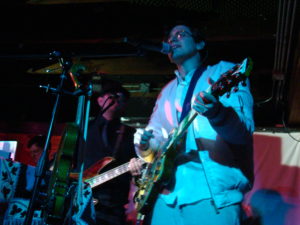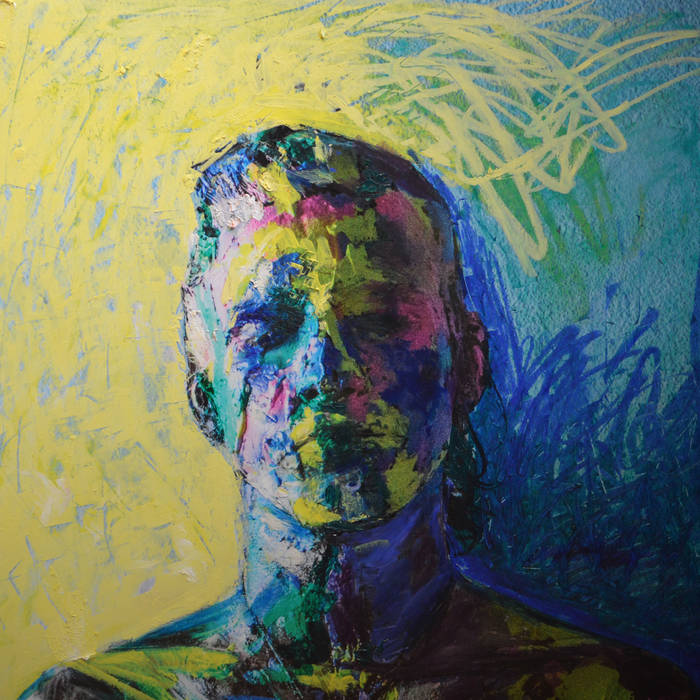
Richie Nelson of Richie Dagger’s Crime gets psychedelic. (photo: Tony Kay)
Artist Home is proud to give you your first glimpse into the world of Richie Dagger’s Crime, and a listen to tracks from the band’s great new full-length, Sea of Dysfunction. How great is it? Listen, and read on.
Singer/songwriter/multi-instrumentalist Richie Nelson has been dwelling amidst the Seattle music scene for over a decade. In that time, he’s been in scores of bands, and become a respected collaborator/producer for several electronic music and hip hop outfits. After a couple of informal releases of demos, mixes, and remixes under the nom de muse of Richie Dagger’s Crime, he and his band came into their own with the release of 2017’s Tenderness.
That very sharp EP of cover tunes cohered RDC as a genuine band, and it cemented Nelson’s production style, a wedding of ’80’s retro with 21st century layers of electronics.
All of the promise inherent in Nelson’s production work, and in his reimagining of others’ material, comes to full flower on Sea of Dysfunction. Simply put, this is easily one of the richest, most sonically ambitious listening experiences you’ll get from any Northwest band this year.
RDC’s sound has always incorporated elements of electronica, new wave, funk, and soul, and true to form, and Sea of Dysfunction draws from those elements with everything-including-the-kitchen-sink liberalness. But Nelson’s also incorporated elements of psychedelia, folk, and found-sound ambience into the record. All of the above cohere into a journey that makes the most of its epic (by modern standards) 50-minute, 15-track duration.
Sea of Dysfunction isn’t really a staid concept album, but a search for transcendence threads throughout. Nelson assumes the role of holistic healer when he croons, “Go ahead, repeat the lines/ breathe in; even, balanced strides,” on the stark, ethereal yet funky “Envisioned Tides.” The protagonist of the single, “Living in a Magazine,” seeks elevation through the illusory allure of the selfie-saturated internet era (“Take our picture, so we can feel”). Nelson also mines the vein of transcendence through sensuality on “Haunt Me.”
The elemental nature of the lyrics throughout Sea of Dysfunction runs parallel to song structures that are augmented by a layered, imaginative production. Each track’s fairly bursting with strange, immersive noises and unusual percussion. Miraculously, the cumulative effect somehow manages to be incredibly tricky while still mining a rich vein of hooks and melody.

“Haunt Me” begins with rapidly-strummed acoustic guitar that promises jangly indie-folk, only to shift into a hiccuping, ever-changing funk groove with a very catchy ‘na na na’ refrain. “Natural Wax Paper Light” opens with a wash of synths and percussion that sound like an African music box. A dark (sampled?) bass line straight out of a blaxploitation movie throbs, and a space-age dance vibe fully kicks in. Eerie, fuzzed-out guitars that wouldn’t be out of place in an Italian horror movie even surface before the song rediscovers its danceability.
There’s no denying that Nelson occupies the center of RDC, but his collaborative sense enriches Sea of Dysfunction considerably. Chief among the co-conspirators is Kjell Nelson (no relation), best known as a hip hop producer on records by Silas Blak, Kung Foo Grip, and others. Kjell co-produced, co-wrote “Living in a Magazine,” and crafted the odd found-sound interludes and intro that provide the record’s textural glue.
The most fertile ensemble work’s found on “Living in a Magazine,” a glorious combination of Burt Bacharach swing and psychedelic pop immeasurably enriched by Eric Padget’s confident trumpet blasts and Coreena Brown’s soulful backing vocals. It’s the most straightforward pop song on Sea of Dysfunction, and it’s utterly addictive.

RIchie Dagger’s Crime. (photo: Tony Kay)
As befits any journey towards transcendence, Sea of Dysfunction ain’t all smiles and relaxed meditation. “I Bleed the Future Seeds” is flat-out apocalyptic spaghetti western goth, with descending electric guitars and Nelson employing a high, creepy trill that sounds like Jeff Buckley’s malevolent twin. And on “Absence (Part 2)” Nelson sings “there’s a child in my heart who often hides” with childlike fragility, only to blurt out the next line (“He can be mad”) repeatedly until he’s screaming the four words out with nerve-rattling intensity.
In the end, though, a sense of joy rules Sea of Dysfunction. There’s unjaded enthusiasm in the record’s lovingly-crafted feel, and in the strains of beauty imbedded in so many of the tracks. The album’s lone cover, a sparkling take on cult folkie Vashti Bunyan’s “Here Before,” is gilded with an arrangement that sounds like the most enchanting song to never appear in an old Walt Disney cartoon.
And there’s no more perfect closer than “Forest Walking,” a quiet, ambling beauty of a tune that sounds like mellow ’70’s AM pop funneled through a bed of beguiling artificial percussion and synths. “Take a stroll in the forest, take off your socks and your shoes/I’ve got nothing to tell you, you’ve got nothing to lose,” Nelson sings. In the end, true transcendence and happiness can be that simple.





